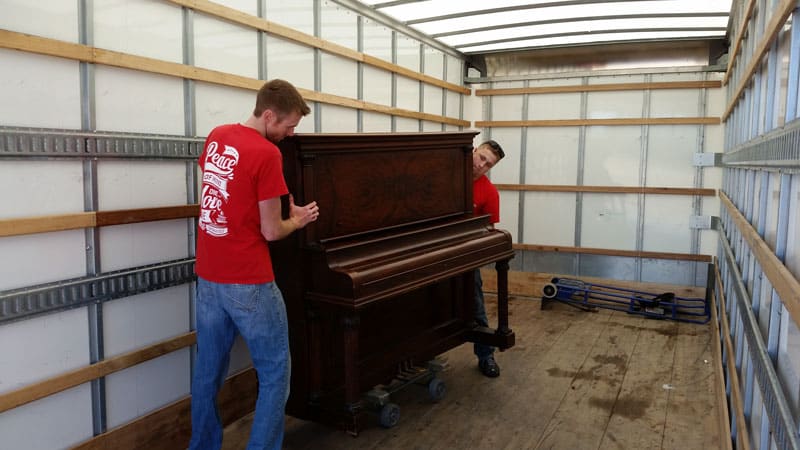
A piano is a heavy, bulky, and delicate instrument. Pianos weigh anywhere from 300 to 1200 pounds (136 kg to 544 kg). A single scratch, bump, or knock can cause significant damage to the sound or value of your piano. So, moving a piano is not just about convenience but protecting your valuable investment. To safely move your piano, you’ll need professional help from movers who use the necessary equipment, like a piano board and heavy-duty straps. If you do decide to move your instrument yourself, here’s what you need to know.
Preparing To Move A Piano
If you’re planning to move a piano by yourself instead of hiring a piano moving service, we recommend following these tips.
Plan Your Route
The first step is to assess the piano and the moving route.
- Look at the piano’s new location and ensure the route is clear and obstacle-free.
- Measure hallways, doorways, and stairways to plan accordingly.
- Assess the piano: is it a grand piano, upright or digital? Differences in size, length, and weight make each piano and each move different.
- Look at the decorative features of the piano that might need extra care during the move.
Gather the Right Equipment
- Heavy-duty lifting straps: To prevent the piano from slipping and tipping, use strong straps.
- Dolly or hand-trucks: To move the piano easily in tight spaces and corners, get a dolly or hand truck, depending on the size of the piano.
- Moving blankets: To cushion the piano so that the blanket absorbs any shock or impact, wrap your piano in moving blankets and secure them with tape or straps.
- Piano Board: For some pianos, such as a concert grand, you may need a piano board to move it safely.
- Tape: Tape can help you secure blankets or the lid of the piano, to prevent any accidents during moving.
- Gloves: To lift the piano safely, it’s important to protect your hands.
Organize a Moving Team
Moving a piano is a lot of work if you’re trying to do it independently. So don’t try to attempt it alone. You’ll need at least need 3-5 people. You may want to hire a professional team or assemble a moving crew to make sure that your piano can be moved safely. Research reputable piano movers in your area and compare quotes before hiring.
Wrap and Secure the Piano
Two of the most crucial steps in moving a piano are wrapping and securing it. Here’s the correct way to wrap and secure a piano:
Remove or Secure Loose Items
Before wrapping the piano, remove any items that could fall or get damaged during the move. So, clear out the loose items on the piano, such as music sheets, books, or other decorations.
Protecting the Piano
The main purpose of blankets or furniture pads is to prevent scratches or dents, so this step is crucial. If you’re moving the piano downstairs or through narrow hallways, wrap your piano with thick and sturdy blankets and use tapes or straps to secure them.
Secure the Piano
Once you’ve wrapped the piano, it’s time to secure it. Use straps or ropes with tape to secure the piano and keep it from shifting and sliding during a move. Don’t tighten the belts to the extent that they might damage the piano.
Lifting the Piano Properly
Once the piano is secure, you can lift it onto a hand truck or dolly. It’s important to lift carefully to protect the instrument and avoid any injuries. For this step:
- Make sure that the piano lid is closed. Lock the top if possible.
- Make sure that the blankets or furniture pads are secure.
- Gather enough people to distribute the weight of the piano safely. Every individual must wear gloves and closed-toe shoes and avoid baggy clothing.
- Ensure even distribution around the piano to distribute its weight.
- Secure the blanket and straps or ropes to the piano in a crisscross pattern beneath the piano.
- Lift the piano using straps and place it on the piano board, dolly, or hand truck.
Move Carefully Through Doorways and Up or Down Stairs
Measure any doorways and hallways before you start to be sure that the piano can fit. When you are moving a piano through narrow doorways, tilt it slightly to one side and rotate through the opening. Make sure not to scrape the side or top of the piano against the door frame. Use a stair ramp to move the piano up or down any stairs.
Moving a Piano to Your New Home
Moving a piano between rooms is one thing, but moving it to another home is even more complicated. If you are planning a move, it’s important to decide ahead of time how you’ll get your piano there. Here are some important steps to remember:
Tip 1: Consider Hiring a Moving Service
Moving a piano from one destination to another will likely require professional help. Professional movers will have the experience and equipment required to carefully navigate your new home with your piano.
Tip 2: Rent the Right Size Truck
A professional full-service moving company can recommend the right size truck for your piano. However, if you’re moving your piano on your own, make sure you’re renting a truck with the right amount of space for your piano. Be careful not to rent a truck that is too big, otherwise your piano is more likely to slide around while it is being moved.
Tip 3: Load the Piano Safely
To load the piano, use the same method you did on the stair ramp. Place movers at each end of the piano, and make sure that it can’t tilt backward or forward while you are loading it.
Tip 4: Strap the Piano In
To do this, use moving straps to strap the piano against the wall of the truck. Tighten the belts so the piano can only shift an inch or so. This will prevent the piano from shifting while you are driving the truck.
After the Move
Once you’ve arrived at your new home, use the same techniques to unload your piano and move it into your new home with caution. Once you unwrap it, it’s important to check for any damage right away.
Check for Any Damage
Look at the piano’s exterior, especially the legs, pedals, and corners. Check for chips, dents, or cracks around the piano. If you used professional movers, you may have insurance coverage for any damage that occurred.
Tune Your Piano
Depending on the distance of the move and the conditions your piano was exposed to, you may need to tune it once you’ve moved. It’s better to let your piano acclimatize to your new home than to tune it right away. Changes in temperature and humidity may affect your piano gradually in your new home, so waiting for at least a few weeks is best.
Maintain Your Piano
- Always check the temperature and humidity level of the room where your piano is. The best temperature is 68 to 72 degrees Fahrenheit. The best humidity level is 40%-50%.
- Don’t place the piano near direct heat or cold. Avoid placing it in front of a drafty window or radiator.
- Clean your piano, but avoid using harsh chemicals.
- Cover the piano with a cover or blanket to protect it from dust, spills, or scratches during moving or renovation.
Key Takeaways
Moving a piano to its new location or home needs comprehensive planning and preparation. Always place the piano carefully in its new destination, with ample space and protection from direct sunlight and moisture. Do your research first and gather the necessary instruments. You can protect and play your piano for years by following these simple steps!





